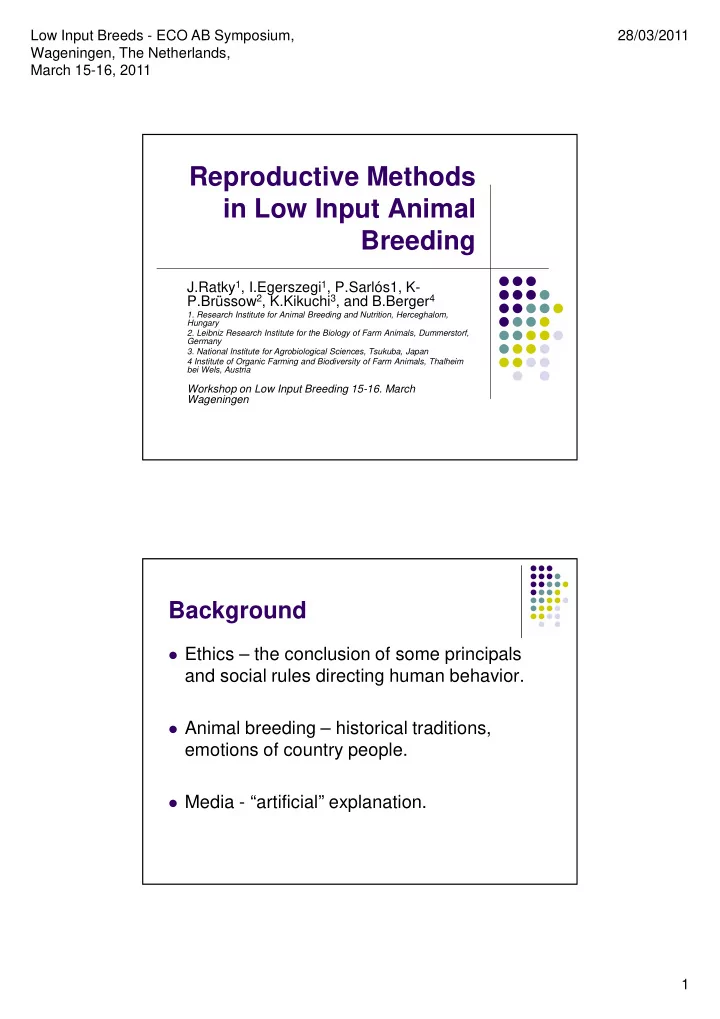

Low Input Breeds - ECO AB Symposium, 28/03/2011 Wageningen, The Netherlands, March 15-16, 2011 Reproductive Methods in Low Input Animal Breeding J.Ratky 1 , I.Egerszegi 1 , P.Sarlós1, K- P.Brüssow 2 , K.Kikuchi 3 , and B.Berger 4 1. Research Institute for Animal Breeding and Nutrition, Herceghalom, Hungary 2. Leibniz Research Institute for the Biology of Farm Animals, Dummerstorf, Germany 3. National Institute for Agrobiological Sciences, Tsukuba, Japan 4 Institute of Organic Farming and Biodiversity of Farm Animals, Thalheim bei Wels, Austria Workshop on Low Input Breeding 15-16. March Wageningen Background � Ethics – the conclusion of some principals and social rules directing human behavior. � Animal breeding – historical traditions, emotions of country people. � Media - “artificial” explanation. 1
Low Input Breeds - ECO AB Symposium, 28/03/2011 Wageningen, The Netherlands, March 15-16, 2011 Ethical aspects of reproductive methods in LIB - Human factors rural local and � regional healthy food supply rural development i.e. � reducing unemployment maintaining � agriculture traditions support rural tourism � environment � protection. Ethical aspects of reproductive methods in LIB - Animal factors � gene conservation � animal welfare � actual demands 2
Low Input Breeds - ECO AB Symposium, 28/03/2011 Wageningen, The Netherlands, March 15-16, 2011 � Low Input Breeding = Low Input of Knowledge � Indigenous knowledge + Updated science � Modest behavior of scientists Minimal Preconditions � animal health conditions � individual registration of animals � exact documentation of mating or artificial insemination (AI) 3
Low Input Breeds - ECO AB Symposium, 28/03/2011 Wageningen, The Netherlands, March 15-16, 2011 Hungary � Our experiences on reproductive techniques in LIB � Special importance in Hungary � International research projects � Animal breeds in LIB are mostly indigenous and sometimes endangered � Adapted to the climate of Carpathian Basin very well during recent centuries. Country specific factors � traditional breeds � national value � rural development � rural tourism � unique processed products i.e. Hungarian winter salami, sausage, bacon 4
Low Input Breeds - ECO AB Symposium, 28/03/2011 Wageningen, The Netherlands, March 15-16, 2011 Hungarian specific situation � Hungarian Grey cattle (6000) � Mangalica pig (7000) � Racka sheep (6450) Mangalica pig � Blond, � Red and � Swallow Belly Mangalica 5
Low Input Breeds - ECO AB Symposium, 28/03/2011 Wageningen, The Netherlands, March 15-16, 2011 Utilization Small and large scale farms in the past and it is the same in the present. SME, „family farms” & Large Units � Large companies integrated small farmers, organized the breeding and trading. � Mangalica Breeding Association – a guidance for members, supply boars or semen 6
Low Input Breeds - ECO AB Symposium, 28/03/2011 Wageningen, The Netherlands, March 15-16, 2011 Reproductive management 1 � Natural mating and AI – small and large farms. In some blood strains the low number of animals evidently needs natural mating for in vivo gene preservation. In some production units AI is a daily practice. Reproductive management 2 � AI in any production units!! � Less costly than minimally 5 times more boars � Dedicated work AI much different, more complicated in native breeds � In male as well as female reproductive physiology. 7
Low Input Breeds - ECO AB Symposium, 28/03/2011 Wageningen, The Netherlands, March 15-16, 2011 Reproductive management 3 � Semen freezing (involved farmers and companies and research units) � Boar semen cryo- preservation is not clearly solved � In Mangalica (average 50% post-thaw motility). Special cases � National parks demonstrate agriculture traditions and � Indigenous domestic breeds e.g. Mangalica – pure bred population, old, typical LIB circumstances. Low productivity!! � Organic farming e.g. Austria 8
Low Input Breeds - ECO AB Symposium, 28/03/2011 Wageningen, The Netherlands, March 15-16, 2011 Racka sheep � two color types i.e. White and Black Racka � national parks � enthusiastic sheep breeders � village hotels Utilization perspectives 1 � lower meat yield % (in (S)EUROPE classification) � excellent for LIB in continental climate � rural development programs in remote areas www.teagasc.ie 9
Low Input Breeds - ECO AB Symposium, 28/03/2011 Wageningen, The Netherlands, March 15-16, 2011 Utilization perspectives 2 � Priority of reproductive management (Hungarian Sheep Breeders’ Association) preservation!! � Natural mating by selected rams. R & D in Racka reproduction, ATK � in vitro preservation � To train Racka rams for semen collection – hard job � 75 ewes and 20 rams � 16 rams for semen collection � more than 50 % post- thaw motility 10
Low Input Breeds - ECO AB Symposium, 28/03/2011 Wageningen, The Netherlands, March 15-16, 2011 Conclusion � LIB has a special significance in modern animal breeding � Rural tourism and rural development � Larger production amount - adaptation of modern and more effective system � Innovation � Reproductive methods in LIB – not closed eyes and ears – opened for new results, farmers improve their dedicated work Thank you very much for your kind attention! 11
Recommend
More recommend